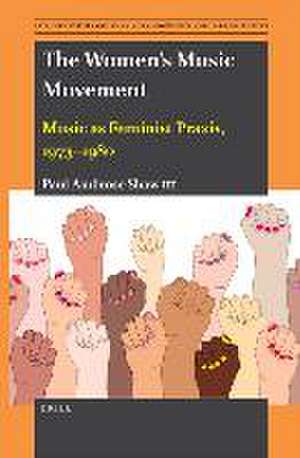The Women’s Music Movement: Music as Feminist Praxis, 1973–1980: Arts, Creativities, and Learning Environments in Global Perspectives, cartea 8
Autor Paul Ambrose Shaw IIIen Limba Engleză Paperback – 30 noi 2022
Preț: 292.55 lei
Nou
Puncte Express: 439
Preț estimativ în valută:
55.99€ • 60.79$ • 47.03£
55.99€ • 60.79$ • 47.03£
Carte indisponibilă temporar
Doresc să fiu notificat când acest titlu va fi disponibil:
Se trimite...
Preluare comenzi: 021 569.72.76
Specificații
ISBN-13: 9789004534964
ISBN-10: 9004534962
Pagini: 124
Dimensiuni: 155 x 235 mm
Greutate: 0 kg
Editura: Brill
Colecția Brill
Seria Arts, Creativities, and Learning Environments in Global Perspectives
ISBN-10: 9004534962
Pagini: 124
Dimensiuni: 155 x 235 mm
Greutate: 0 kg
Editura: Brill
Colecția Brill
Seria Arts, Creativities, and Learning Environments in Global Perspectives
Notă biografică
Paul Ambrose Shaw III, Ph.D. (2022), Union Institute and University, is Adjunct Professor of Humanities at United States University. He has published two drum set instructional books and two peer reviewed publications on the music of the Gullah Geechee.
Cuprins
Preface
Acknowledgements
Introduction: Why This Study?
1 How a Musical Lens Can Inform SWF Narratives
1 Feminism and Women’s Music: Definitions, Context, and Terms
1 Intersectionality
2 Background
3 Context
4 Abbreviations
2 Considerations: Epistemology, Feminist Criteria, Gender and Pop
1 Epistemology and Feminist Art Criteria
2 A Case for more Musical, Lyrical (Semiotic) Scholarship: Gender and Pop
3 Music as Social, Personal, and Political
4 Analysis Process: Limitations, the Songwriters, and the Songs
1 A Note on Process
2 Limitations and Assumptions
3 The Songwriters
4 The Songs
5 Meg Christian’s “Valentine Song”
1 Rhythm (Foundational Rhythm, Time Signature, Tempo, Delay, Anticipation, Repetition)
2 Melodic and Harmonic Features (Key Signature, Vocal Range, Homophony, Polyphony, Texture)
3 Form and Style (Variation, Unity, Repetition)
4 Dynamics
5 Musical Example
6 Timbre (Color, Tone, Inflection)
7 Lyrics
8 Valentine Song (Meg Christian) Guitar Capo 1st Fret (actual key-Ab)
9 “Valentine Song” Conclusion
6 Ferron’s “Ain’t Life a Brook”
1 Rhythm (Foundational Rhythm, Time Signature, Tempo, Delay, Anticipation, Repetition)
2 Musical Example
3 Melodic and Harmonic Features (Key Signature, Vocal Range, Homophony, Polyphony, Texture)
4 Form and Style (Variation, Unity, Repetition)
5 Dynamics
6 Timbre (Color, Tone, Inflection)
7 Lyrics
8 Ain’t Life a Brook (Ferron) Guitar Capo 7th Fret (Actual Key-D)
9 “Ain’t Life a Brook” Conclusion
7 Cris Williamson’s “Sister”
1 Rhythm (Foundational Rhythm, Time Signature, Tempo, Delay, Anticipation, Repetition)
2 Melodic and Harmonic Features (Key Signature, Vocal Range, Homophony, Polyphony, Texture)
3 Form and Style (Variation, Unity, Repetition)
4 Dynamics
5 Musical Example
6 Timbre (Color, Tone, Inflection)
7 Lyrics
8 Sister (Cris Williamson) Original Key-C (for Piano or Guitar)
9 “Sister” Conclusion
8 Holly Near’s “Riverboat”
1 A Note on Inclusion: Why Near?
2 Rhythm (Foundational Rhythm, Time Signature, Tempo, Delay, Anticipation, Repetition)
3 Melodic and Harmonic Features (Key Signature, Vocal Range, Homophony, Polyphony, Texture)
4 Form and Style (Variation, Unity, Repetition)
5 Dynamics
6 Timbre (Color, Tone, Inflection)
7 Musical Example
8 Lyrics
9 Riverboat (Holly Near) Original Key-D (for Piano or Guitar)
10 “Riverboat” Conclusion
9 Linda Tillery’s “Womanly Way”
1 Rhythm (Foundational Rhythm, Time Signature, Tempo, Delay, Anticipation, Repetition)
2 Musical Example
3 Musical Example
4 Musical Example
5 Melodic and Harmonic Features (Key Signature, Vocal Range, Homophony, Polyphony, Texture)
6 Form and Style (Variation, Unity, Repetition)
7 Dynamics
8 Timbre (Color, Tone, Inflection)
9 Lyrics
10 Womanly Way (Linda Tillery) Original Key-Bb (for Piano or Guitar)
11 “Womanly Way” Conclusion
10 Women’s Music Movement Conclusion
References
Index
Acknowledgements
Introduction: Why This Study?
1 How a Musical Lens Can Inform SWF Narratives
1 Feminism and Women’s Music: Definitions, Context, and Terms
1 Intersectionality
2 Background
3 Context
4 Abbreviations
2 Considerations: Epistemology, Feminist Criteria, Gender and Pop
1 Epistemology and Feminist Art Criteria
2 A Case for more Musical, Lyrical (Semiotic) Scholarship: Gender and Pop
3 Music as Social, Personal, and Political
4 Analysis Process: Limitations, the Songwriters, and the Songs
1 A Note on Process
2 Limitations and Assumptions
3 The Songwriters
4 The Songs
5 Meg Christian’s “Valentine Song”
1 Rhythm (Foundational Rhythm, Time Signature, Tempo, Delay, Anticipation, Repetition)
2 Melodic and Harmonic Features (Key Signature, Vocal Range, Homophony, Polyphony, Texture)
3 Form and Style (Variation, Unity, Repetition)
4 Dynamics
5 Musical Example
6 Timbre (Color, Tone, Inflection)
7 Lyrics
8 Valentine Song (Meg Christian) Guitar Capo 1st Fret (actual key-Ab)
9 “Valentine Song” Conclusion
6 Ferron’s “Ain’t Life a Brook”
1 Rhythm (Foundational Rhythm, Time Signature, Tempo, Delay, Anticipation, Repetition)
2 Musical Example
3 Melodic and Harmonic Features (Key Signature, Vocal Range, Homophony, Polyphony, Texture)
4 Form and Style (Variation, Unity, Repetition)
5 Dynamics
6 Timbre (Color, Tone, Inflection)
7 Lyrics
8 Ain’t Life a Brook (Ferron) Guitar Capo 7th Fret (Actual Key-D)
9 “Ain’t Life a Brook” Conclusion
7 Cris Williamson’s “Sister”
1 Rhythm (Foundational Rhythm, Time Signature, Tempo, Delay, Anticipation, Repetition)
2 Melodic and Harmonic Features (Key Signature, Vocal Range, Homophony, Polyphony, Texture)
3 Form and Style (Variation, Unity, Repetition)
4 Dynamics
5 Musical Example
6 Timbre (Color, Tone, Inflection)
7 Lyrics
8 Sister (Cris Williamson) Original Key-C (for Piano or Guitar)
9 “Sister” Conclusion
8 Holly Near’s “Riverboat”
1 A Note on Inclusion: Why Near?
2 Rhythm (Foundational Rhythm, Time Signature, Tempo, Delay, Anticipation, Repetition)
3 Melodic and Harmonic Features (Key Signature, Vocal Range, Homophony, Polyphony, Texture)
4 Form and Style (Variation, Unity, Repetition)
5 Dynamics
6 Timbre (Color, Tone, Inflection)
7 Musical Example
8 Lyrics
9 Riverboat (Holly Near) Original Key-D (for Piano or Guitar)
10 “Riverboat” Conclusion
9 Linda Tillery’s “Womanly Way”
1 Rhythm (Foundational Rhythm, Time Signature, Tempo, Delay, Anticipation, Repetition)
2 Musical Example
3 Musical Example
4 Musical Example
5 Melodic and Harmonic Features (Key Signature, Vocal Range, Homophony, Polyphony, Texture)
6 Form and Style (Variation, Unity, Repetition)
7 Dynamics
8 Timbre (Color, Tone, Inflection)
9 Lyrics
10 Womanly Way (Linda Tillery) Original Key-Bb (for Piano or Guitar)
11 “Womanly Way” Conclusion
10 Women’s Music Movement Conclusion
References
Index









